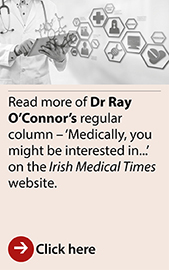Fitness
You might be interested in…Screening

Dr Ray O’Connor looks at the latest clinical studies on screening for breast and prostate cancer
a. Colorectal cancer screening
Population-based colorectal cancer (CRC) screening programs are implemented worldwide, but there are difficulties evaluating their effectiveness. The magnitude of routine CRC screening effectiveness regarding cancer-specific mortality is unclear.
Dr Ray O’Connor
This prospective cohort study1 was performed in the region of Stockholm, Sweden, between 2008, and 2021. All 379,448 individuals of the target population for screening born from 1938 to 1954 were included.
The objective was to evaluate cancer-specific mortality associated with early vs late or no invitation for routine CRC screening using faecal occult blood testing (FOBT). The findings were that there was a statistically significant 14 per cent decreased CRC mortality among individuals who received early invitation to FOBT screening, compared with individuals who received late or no invitation after a maximum of 14 years of follow-up. The authors conclude that population-based CRC screening with FOBT was associated with decreased CRC mortality. The effect on overall mortality is not mentioned.
b. Prostate Cancer Screening
The research question for this systematic review and meta-analysis2 was “Do prostate cancer screening pathways that incorporate magnetic resonance imaging (MRI) and targeted biopsies outperform strategies that rely solely on prostate-specific antigen testing and systematic biopsy?” The authors studied results on 80,114 screened men from 12 studies.
 The findings were that MRI-based screening was found to be associated with a reduced number of unnecessary prostate biopsies and detection of clinically insignificant prostate cancer while maintaining the detection of clinically significant prostate cancer compared with prostate-specific antigen–only strategies. The authors conclude that their findings support the integration of prostate MRI in prostate cancer screening to improve the balance of patient harms and benefits.
The findings were that MRI-based screening was found to be associated with a reduced number of unnecessary prostate biopsies and detection of clinically insignificant prostate cancer while maintaining the detection of clinically significant prostate cancer compared with prostate-specific antigen–only strategies. The authors conclude that their findings support the integration of prostate MRI in prostate cancer screening to improve the balance of patient harms and benefits.
The Cluster Randomized Trial of PSA Testing for Prostate Cancer (CAP)3 reported no effect of prostate-specific antigen (PSA) screening on prostate cancer mortality at a median 10-year follow-up, but the long-term effects of PSA screening on prostate cancer mortality remains unclear.
In this secondary analysis of a randomized clinical trial of 415,357 men aged 50 to 69 years randomized to a single invitation for PSA screening (n = 195 912) or a control group without PSA screening (n = 219 445) and followed up for a median of 15 years, risk of death from prostate cancer was lower in the group invited to screening (0.69 per cent vs 0.78 per cent; mean difference, 0.09 per cent) compared with the control group.
The authors concluded that compared with no invitation for routine PSA testing, a single invitation for a PSA screening test reduced prostate cancer mortality at a median follow-up of 15 years, but the absolute mortality benefit was small.
c. Screening for Breast Cancer
Among all US women, breast cancer is the second most common cancer and the second most common cause of cancer death. In 2023, an estimated 43,170 women died of breast cancer. The United States Preventative Services Task Force (USPSTF) commissioned a systematic review to evaluate the comparative effectiveness of different mammography-based breast cancer screening strategies by age to start and stop screening, screening interval, modality, use of supplemental imaging, or personalization of screening for breast cancer on the incidence of and progression to advanced breast cancer, breast cancer morbidity, and breast cancer–specific or all-cause mortality.
The population was cisgender women and all other persons assigned female at birth aged 40 years or older at average risk of breast cancer. The resulting recommendation is for biennial screening mammography for women aged 40 to 74 years. (B recommendation). The USPSTF concludes that the current evidence is insufficient to assess the balance of benefits and harms of screening mammography in women 75 years or older. (I statement)
The USPSTF also concludes that the current evidence is insufficient to assess the balance of benefits and harms of supplemental screening for breast cancer using breast ultrasonography or MRI in women identified to have dense breasts on an otherwise negative screening mammogram. (I statement).
References
- Blom J et al. Routine Fecal Occult Blood Screening and Colorectal Cancer Mortality in Sweden. JAMA Network Open. 2024;7(2):e240516. doi:10.1001/jamanetworkopen.2024.0516
- Fazekas T et al. Magnetic Resonance Imaging in Prostate Cancer Screening A Systematic Review and Meta-Analysis. JAMA Oncol. Published online April 5, 2024. doi:10.1001/jamaoncol.2024.0734
- Martin R et al. Prostate-Specific Antigen Screening and 15-Year Prostate Cancer Mortality A Secondary Analysis of the CAP Randomized Clinical Trial. JAMA. doi:10.1001/jama.2024.4011 Published online April 6, 2024.
- US Preventive Services Task Force. Screening for Breast Cancer US Preventive Services Task Force Recommendation Statement. JAMA. doi:10.1001/jama.2024.5534 Published online April 30, 2024.










